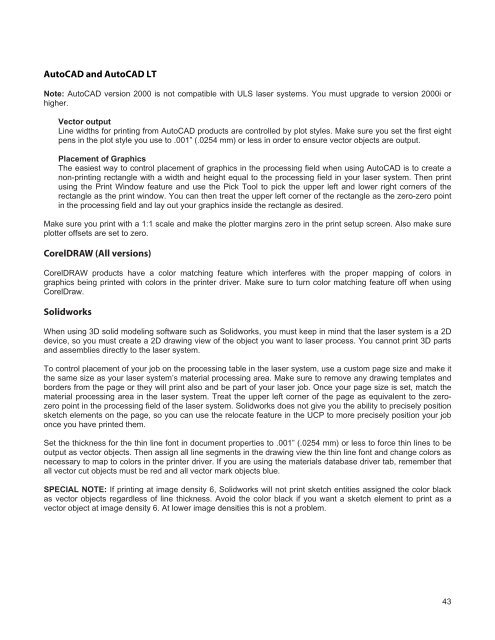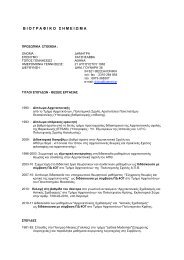VersaLASER® (VLS) User Guide VLS2.30, VLS3.50
VersaLASER® (VLS) User Guide VLS2.30, VLS3.50
VersaLASER® (VLS) User Guide VLS2.30, VLS3.50
You also want an ePaper? Increase the reach of your titles
YUMPU automatically turns print PDFs into web optimized ePapers that Google loves.
AutoCAD and AutoCAD LT<br />
Note: AutoCAD version 2000 is not compatible with ULS laser systems. You must upgrade to version 2000i or<br />
higher.<br />
Vector output<br />
Line widths for printing from AutoCAD products are controlled by plot styles. Make sure you set the first eight<br />
pens in the plot style you use to .001” (.0254 mm) or less in order to ensure vector objects are output.<br />
Placement of Graphics<br />
The easiest way to control placement of graphics in the processing field when using AutoCAD is to create a<br />
non-printing rectangle with a width and height equal to the processing field in your laser system. Then print<br />
using the Print Window feature and use the Pick Tool to pick the upper left and lower right corners of the<br />
rectangle as the print window. You can then treat the upper left corner of the rectangle as the zero-zero point<br />
in the processing field and lay out your graphics inside the rectangle as desired.<br />
Make sure you print with a 1:1 scale and make the plotter margins zero in the print setup screen. Also make sure<br />
plotter offsets are set to zero.<br />
CorelDRAW (All versions)<br />
CorelDRAW products have a color matching feature which interferes with the proper mapping of colors in<br />
graphics being printed with colors in the printer driver. Make sure to turn color matching feature off when using<br />
CorelDraw.<br />
Solidworks<br />
When using 3D solid modeling software such as Solidworks, you must keep in mind that the laser system is a 2D<br />
device, so you must create a 2D drawing view of the object you want to laser process. You cannot print 3D parts<br />
and assemblies directly to the laser system.<br />
To control placement of your job on the processing table in the laser system, use a custom page size and make it<br />
the same size as your laser system’s material processing area. Make sure to remove any drawing templates and<br />
borders from the page or they will print also and be part of your laser job. Once your page size is set, match the<br />
material processing area in the laser system. Treat the upper left corner of the page as equivalent to the zerozero<br />
point in the processing field of the laser system. Solidworks does not give you the ability to precisely position<br />
sketch elements on the page, so you can use the relocate feature in the UCP to more precisely position your job<br />
once you have printed them.<br />
Set the thickness for the thin line font in document properties to .001” (.0254 mm) or less to force thin lines to be<br />
output as vector objects. Then assign all line segments in the drawing view the thin line font and change colors as<br />
necessary to map to colors in the printer driver. If you are using the materials database driver tab, remember that<br />
all vector cut objects must be red and all vector mark objects blue.<br />
SPECIAL NOTE: If printing at image density 6, Solidworks will not print sketch entities assigned the color black<br />
as vector objects regardless of line thickness. Avoid the color black if you want a sketch element to print as a<br />
vector object at image density 6. At lower image densities this is not a problem.<br />
43




